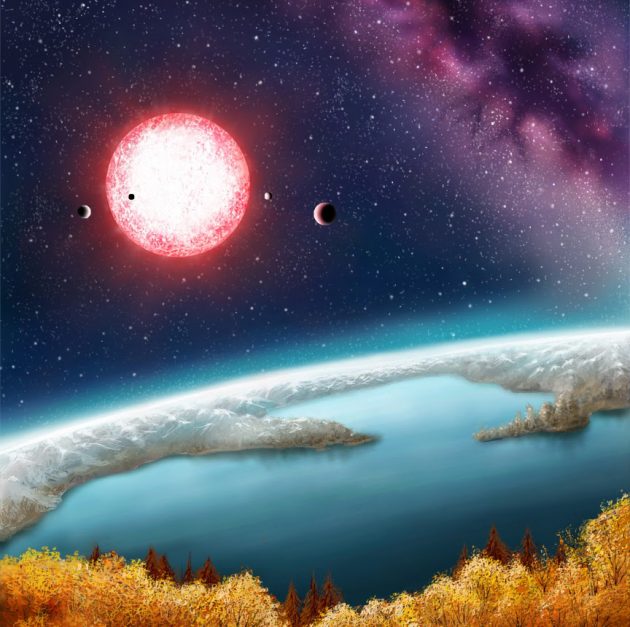
Kepler-186f, seen here in an artist’s rendering and discovered in 2014 by a team of astronomers, is one of more than 200 “exoplanets” that researchers say lie within the “habitable zone” of their stars and could potentially have life. (NASA image by Danielle Futselaar)
Looking for another Earth? An international team of researchers has pinpointed which of the more than 4,000 exoplanets discovered by NASA’s Kepler mission are most likely to be similar to our rocky home.
The research, detailed in an article to be published in the Astrophysical Journal, outlines 216 Kepler planets located within the “habitable zone” — the area around a star in which a planet’s surface could hold liquid water. Of those, 20 are named the best candidates to be habitable rocky planets like Earth.
“This is the complete catalog of all of the Kepler discoveries that are in the habitable zone of their host stars,” said Stephen Kane, an associate professor of physics and astronomy at San Francisco State University and lead author of the study. “That means we can focus in on the planets in this paper and perform follow-up studies to learn more about them, including if they are indeed habitable.”
Studying and cataloging the more than 4,000 exoplanets took more than three years and involved researchers at the Harvard-Smithsonian Center for Astrophysics, NASA, Arizona State University, Caltech, University of Hawaii-Manoa, the University of Bordeaux and Cornell University.

This figure shows the habitable zone for stars of different temperatures, as well as the location of terrestrial size planetary candidates and confirmed Kepler planets described in new research from SF State astronomer Stephen Kane. Some of the Solar System terrestrial planets are also shown for comparison. (Image by Chester Harman)
The research also confirms that the distribution of Kepler planets within the habitable zone is the same as the distribution of those outside of it — additional evidence that the universe is teeming with planets and moons where life could potentially exist.
The boundaries of the habitable zone are critical. If a planet is too close to its star, it will experience a runaway greenhouse gas effect, like Venus. But if it’s too far, any water will freeze, as is seen on Mars. The authors sorted the planets by whether they were in a conservative or a more optimistic interpretation of the habitable zone. Then they further sorted them by size: smaller, rocky planets versus larger gas giants.
The four categories are aimed at helping astronomers focus their research. Those looking for moons that could potentially hold life can study exoplanets in the gas giant categories, for example.
The 20 planets in the most restrictive category — rocky surface and a conservative habitable zone — are the most likely to be similar to Earth. The authors have already begun gathering additional data on these planets, as well as those in the other categories.
“A catalog of Kepler habitable zone exoplanet candidates,” by Stephen R. Kane, Michelle L. Hill, James F. Kasting, Ravi Kumar Kopparapu, Elisa V. Quintana, Thomas Barclay, Natalie M. Batalha, William J. Borucki, David R. Ciardi, Nader Haghighipour, Natalie R. Hinkel, Lisa Kaltenegger, Franck Selsis and Guillermo Torres, can be read online at https://arxiv.org/abs/1608.00620 and will be published in an upcoming print edition of the Astrophysical Journal.





